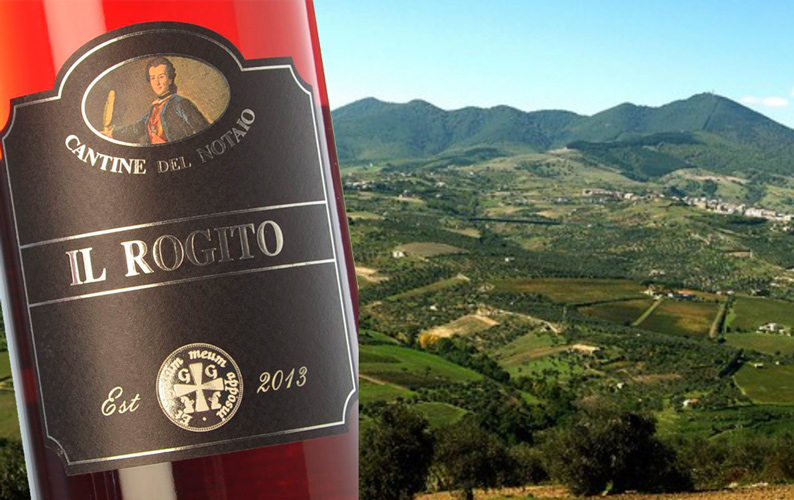An aglianico rosé by Cantine del Notaio is my wine of the month for July. Combining power and refinement, this Southern Italian gem will make you forget what you thought you knew about rosé wines!
One of my recent wine obsessions is to discover great rosé wines from Southern Italy. They might not be as popular as Provencal ones, but I personally find these wines much more interesting and varied. But being Italian (and from the South), of course I’m biased.
A couple of weeks ago my vinous longings were satisfied when I had “Il Rogito” from Cantine del Notaio. A rosé from the Basilicata region, made entirely from the aglianico grape.
Where the wine is from: Basilicata
When a wine lover thinks of the wonderful drinking possibilities offered by Italy, the region of Basilicata hardly comes to mind. In fact, Basilicata isn’t the first thought of anybody thinking about Italy. It’s a pity. Basilica has a lot to offer, both for wine (probably the best source of value for money bottles) and in respect of naturalistic and cultural heritage.
Just a couple of examples of Basilicata’s natural and cultural wonders are Pollino National Park and Matera. The stunning Pollino National Park is the uncontaminated green hearth of Southern Italy. Dotted by the spectacular Heldreich’s pines (called “Pino Loricato” in Italian), the park is a peaceful land dominated by thick forests, crystalline streams and rolling hills. Matera, one of the main cities of Basilicata, is a UNESCO World Heritage Site. The ancient part of the town (called “Sassi”, the rocks) features prehistoric dwellings, beautifully interspersed with medieval buildings carved into the local white calcareous rocks.

Geographically, Basilicata sits between the heel (Puglia) and the toe (Calabria) of Italy. The region is almost landlocked and dominated by hills and mountains. These climatic conditions offer clear advantages for winemaking. The region is south enough to enjoy warm temperatures and plenty of sunshine. Full ripening of grapes is seldom a problem. At the same time, altitude translates into a higher diurnal excursion which in turn ensures good acidity and prevents the loss of nuanced aromas.
From a viticultural standpoint, the most interesting area in Basilicata is the Vulture Massif near Potenza (the capital of Basilicata), in the north of the region. Here vineyards sit on volcanic soil – Mount Vulture is actually an extinct volcano.
Aglianico: probably Italian best grape variety?
The volcanic soil around Mount Vulture is the favourite terroir of the aglianico grape varieties. This cultivar is truly the star of Basilicata’s wine scene.
Aglianico is still a mystery for wine scholars. The parents of aglianico (in terms of other grapes varieties) are unknown as are its geographical origins. One theory is that aglianico was brought to Southern Italy by Ancient Greeks (according to this theory the name “aglianico” is the transposition of “Hellenico”). Some think aglianico originated from Campania; others believe it came from Basilicata and from there travelled to Campania. Another idea is that the Bourbons brought the grape to Southern Italy from Spain.
Regardless of its origin, aglianico is arguably one of the best native grape varieties of Italy. Only nebbiolo and sangiovese can rival it. But aglianico has an obvious advantage over the other two cultivars. Price. Premium aglianico-based wines cost around a third of their nebbiolo and sangiovese counterparts. Think expensive Barolo or Barbaresco for nebbiolo; pricey Brunello di Montalcino or Chianti Gran Riserva for sangiovese.

Aglianico is characterised by thick skin and a rich phenolic profile. It has a high level of tannins, a towering acidity and a marked spiciness. Aglianico’s aromas are intense, concentrated and focussed. Thanks to the combination of these characteristics, aglianico-based wines have huge cellaring potential. They express the best of their complexity and nuances several years after bottling.
Moreover, aglianico is a very versatile grape variety. When vinified as a red, aglianico can express a wide range of styles. It can be slender and agile or powerful and punchy. While aglianico shines as a red, it can produce gorgeous rosés (like this “Il Rogito” by Cantine del Notaio). Or even a white or a sparkling!
Cantine del Notaio
Among the wine stars of the Vulture district in Basilicata, one that really gleams is Cantine del Notaio. This producer has a fascinating story that I’m glad to share here.
Cantine del Notaio as a commercial wine business only started in 1998. However its vineyards have a long and glorious past as a family property passed from one generation to the next. Gerardo Giuratrabocchetti, the current owner, had the idea of revaluing the overlooked gems of his land and offering them to the general public.

Gerardo fondly remembers a childhood promise his grandfather made to him. His grandfather was a stern and austere man who loved to spend time wandering through the vines. One day, a young Gerardo was in the vineyard when his grandfather turned to him and asked a question. Looking seriously at Gerado, his grandfather asked: “Hey boy, what’s your name?” Young Gerardo feared that his grandad was losing his mind. After all, he couldn’t remember his grandson’s name. “Quickly, tell me, what’s your name?” His grandfather demanded. “Gerardo”, the boy feebly answered. “Exactly, your name is Gerardo” the old man echoed. “The same as mine. That’s why my vineyards will be yours one day!”
Fast-forward some thirty years later. Gerardo Giuratrabocchetti had a degree in Agricultural Science and was an esteemed professor. His father had stopped the family winemaking tradition to pursue a highly regarded career as a notary.
However, the 40 year-old Gerardo felt the urge to reconnect with his roots, collect his family’s heritage and make that the centre of his life. Gerardo Giuratrabocchetti remembered his grandfather’s promise and chose to honour it as fully as he could. Gerardo decided to leave the teaching profession and make wine instead. It was 1998, and Cantine del Notaio was born.
Gerardo Giuratrabocchetti is today one of the key figures in Basilicata’s wine scene – especially in regards to the aglianico grape. Gerardo revolutionised both the image and the style of aglianico, helping to put Basilicata on the wine map.
To get a hint of what this winemaker is capable of, see the tasting notes of “Il Rogito” by Cantine del Notaio below. It’s a terrific rosé wine made from 100% aglianico. Enjoy!

Cantine del Notaio - "Il Rogito" Aglianico Rosato, 2017

 Country: Italy
Region/appellation: Basilicata - Basilicata IGT
Wine style: Dry Rose - Rich and Fruity
Grape(s): Aglianico
Average price: £13
Country: Italy
Region/appellation: Basilicata - Basilicata IGT
Wine style: Dry Rose - Rich and Fruity
Grape(s): Aglianico
Average price: £13
Even though the family has a long-standing winemaking tradition, Cantine del Notaio didn’t become a commercial business until 1998. In that year, owner, Gerardo Giuratrabocchetti, was a celebrated 40 year-old professor with a degree in Agricultural Science. Eager to reconnect with his family heritage, he decided to leave his former profession and become a winemaker.
The estate is named after Gerardo’s father, a well-respected notary. Cantine del Notaio in Italian means “Notary’s Cellars”. Most of the wines are named after official nomenclature of legal deeds in the Italian bureaucracy. For example, the “rogito” (that lends its name to this rosé wine) is a legal document produced by a notary and is typically used to formalise the change of ownership of a house or another property.
The versatility of aglianico is such that it can achieve excellent results even when vinified as a rosé – such as the wine in this case. Aglianico rosé wines are not a recent phenomenon. There is evidence to show that both Adrea Bacci, in this “Natural History of Wines” of 1596 and the historian Lancerio (who was also at the service of Pope Paul III) in the XVI century, praised rosé versions made from aglianico.
Cantine del Notaio harvests the grapes for this rosé in the first week of October, much earlier than the picking for red wines (which can take place as late as the end of November). Before fermentation, the must is macerated for one or two days in temperature-controlled stainless steel. After fermentation, the wine is matured in french oak for 12 months.
Tasting notes
(tasted on: 07-Jul-2019)
This wine has an intense colour. In the glass it appears brilliant and transparent with hues of light ruby and strawberry. To the nose, the wine has a concentrated, deep red fruit character (with a perfect ripeness). Notes of red cherry, strawberry and red plums chase each other, layered with nuances of earth, undergrowth and musky wood. A great spiciness comes through, revealing accents of juniper, pepper, and red spices. A beautiful floral note also emerges – lilies, lavender, rose. An attractive and harmonised nose, intense, balanced, complex and spicy.
On the palate, this rosé unveils a magnificent structure. It’s medium to full in body, with a spiky and extra-lively acidity. It is dense and kinematic in the mouth. The rich and focussed red fruit notes combine with a remarkable spiciness. Aromas of juniper, liquorice, pepper, sage and mediterranean shrubs mingle with violet, rose and a delicate toastiness around the edges. A lovely earthy character reveals its presence everywhere! The flavours are precise, concentrated and refined. A touch of tannic presence, subtle and elegant. This is a bomb of a rosé. A stunning marriage of power and refinement. “Il Rogito” by Cantine del Notaio makes you forget everything you thought you knew about rosé!
Wine and other Stories rating: 9.0/10


Very interesting article!
Thank you Denny! 🙂 Glad that you liked the article… Have you ever tried wine from Cantine del Notaio?